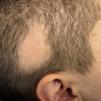The patient was a 26-year-old woman with a single patch of alopecia in the right temporal region that had appeared 2 months earlier. Physical examination revealed a patch of alopecia (6.5×3 cm) with well-defined borders that responded positively in the hair-pull test (Fig. 1). Trichoscopy of one of the borders revealed the presence of exclamation-mark hairs with a thickened distal end (Fig. 2, green arrow), yellow dots (Fig. 2, yellow arrow), short vellus hairs (Fig. 2, orange arrow), angulated hairs (Fig. 2, blue arrow), and hairs with Pohl-Pinkus or monilethrix-like constrictions (Fig. 2, red arrow).
Image of the border of the alopecic plaque acquired using a DermLite II Hybrid dermatoscope (3Gen Inc., CA, USA). Red arrows, hairs with Pohl-Pinkus or monilethrix-like constrictions; green arrows, exclamation-mark hairs with a thickened distal end; yellow arrows, yellow dots; orange arrows, short vellus hairs; blue arrow, angulated hair.
What Is Your Diagnosis?
Alopecia areata (AA) in the active phase.
Trichoscopy is a simple and accessible technique for direct observation of the scalp, follicular orifices, and hair follicles with a dermatoscope, and is used for the diagnosis, follow-up, and treatment monitoring of alopecia patients.1,2
Characteristic features of AA are the presence of exclamation-mark hairs; yellow dots, which correspond to dilated follicular orifices containing keratin plugs; hairs with a tapered proximal end; short vellus hairs (isolated or clustered); zigzag hairs; curved hairs; and Pohl-Pinkus constrictions.
According to Inui et al,3 AA severity is positively correlated with the presence of black and yellow dots, negatively correlated with short vellus hairs, and uncorrelated with the presence of tapered or broken hairs. Those authors also proposed that AA activity is correlated positively with broken hairs, black dots, and tapered hairs, and negatively with short vellus hairs. The most specific diagnostic findings of AA revealed by trichoscopy include black dots, tapered hairs, and broken hairs.3 The main trichoscopic differential diagnosis is trichotillomania. In trichotillomania it is more common to observe broken hairs of variable length, tricoptilosis or split ends (longitudinal fracture of the hair shaft at the distal end), V sign, flame hairs (broken hairs with a translucent distal end), and hair powder.4 In cicatricial alopecia, obliteration of the follicular orifices is more commonly observed.5
Pohl-Pinkus constrictions cause progressive and irregular narrowing along the length of the hair shaft. Because these constrictions tend to cause breakage of the hair shaft, they are rarely observed in trichoscopy of AA (2% of cases). Pohl-Pinkus constrictions are the result of abrupt and repeated arrest of the metabolic and mitotic activity of the hair follicle caused by an internal or external factor, and are observed in many congenital and acquired chronic processes, including AA, chemotherapy-induced alopecia, severe malnutrition, interferon alfa-2c treatment, and severe systemic infections.6 Detection of Pohl-Pinkus constrictions in AA helps confirm the diagnosis, and in some cases enables the identification of flare-ups.
Conflicts of InterestThe authors declare that they have no conflicts of interest.
Please cite this article as: Lobato-Berezo A, Olmos-Alpiste F, Pujol RM, Saceda-Corralo D. Constricciones de Pohl-Pinkus en tricoscopia. ¿Qué indican?. Actas Dermosifiliogr. 2019;110:315–316.










